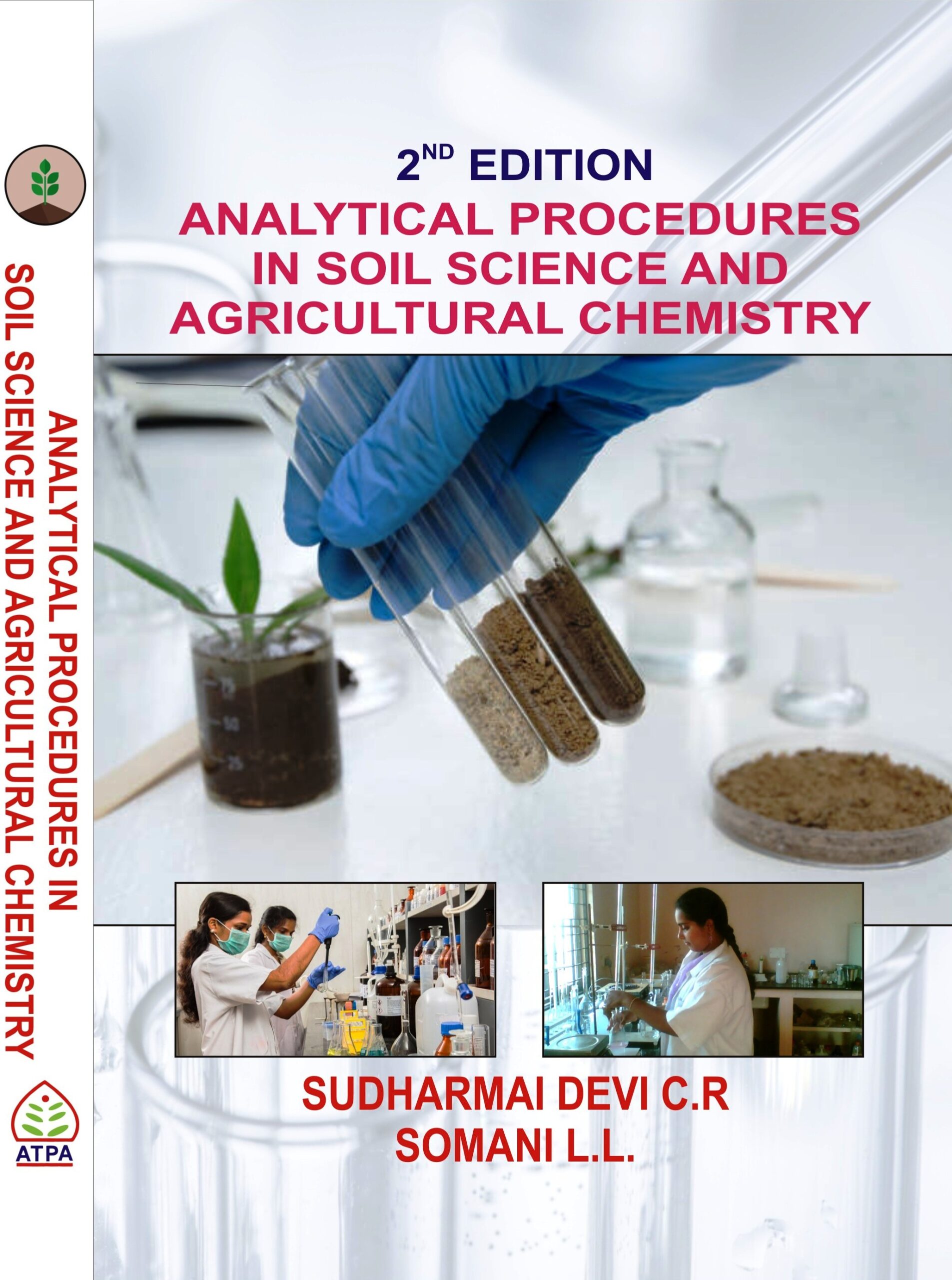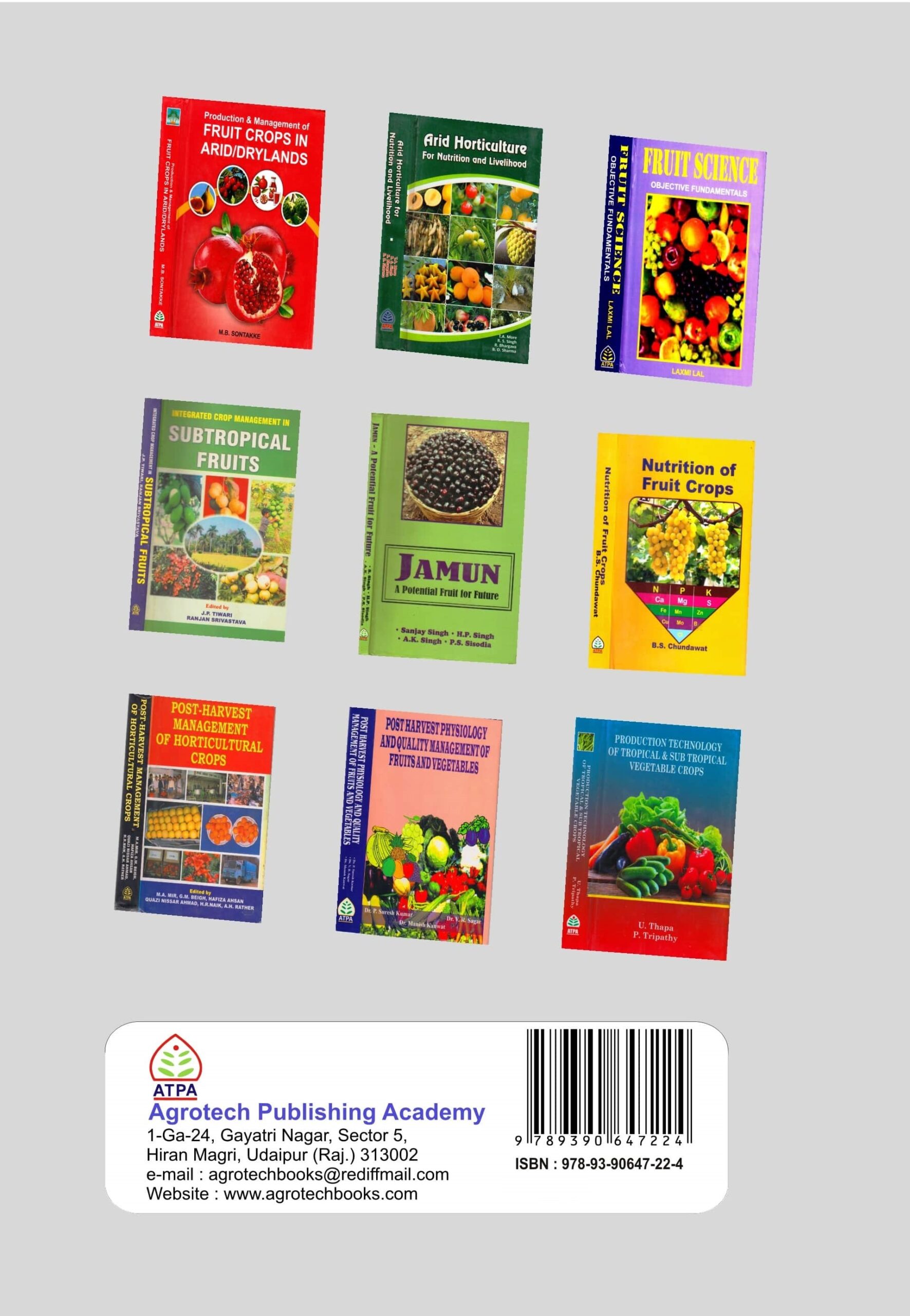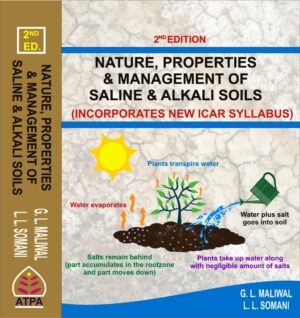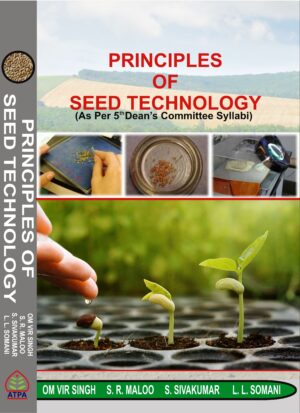ANALYTICAL PROCEDURES IN SOIL SCIENCE AND AGRICULTURAL CHEMISTRY
₹1,250.00
AUTHORS: SUDHARMAI DEVI C.R. & SOMANI L.L.
PUBLISHING YEAR: 2022
EDITION: 2nd
ISBN: 9789390647224
© All Rights Reserved
Description
ABOUT THE BOOK
All scientists generally depend on analysis as a major means of solving scientific problems. This is to enable them proffer solutions to numerous questions on the content of the materials with which they work. The methods by which these analyses are carried out are referred to as analytical techniques. The types of analytical techniques may vary from field to field. This variation stems primarily from differences in the nature of materials with which people in each field works.
Soil science is branch of applied sciences that makes use of the principles of physics, chemistry, biology and mathematics in the study of soil. This is because the soil consists of matter (living and non-living) interacting together physically, chemically and biologically to provide ecosystem services at all levels of consideration. For a soil scientist to be able therefore to answer questions on the constituents of soil, he needs to carry out one form of analysis or the other. Methods of analysis in soil science consist of chemical, biological and physical techniques.
the analytical procedures pertaining to soil, plant, fertilisers and irrigation water are dealt with under separate chapters. the analyrtical methods are chosen in such a way that they are applicabe under the conditions available in most of our soil science laboratories.
Efforts have been made to make the book comprehensive and easy to use. It is hoped that this book would be useful to students, teachers and researches in agriculture and related disciplines. The effort will be rewarding, if the student or researcher finds it handy for most of his requirements.
CONTENTS
| Title | PAGE |
| Preface | 3-4 |
| About The Book | 12 |
| About The Authors | 13 |
| CHAPTERS | |
| 1.0 INTRODUCTION
1.1 Maintenance of a Chemical Analytical Laboratory 1.2 Glassware’s 1.3 Preparation of Reagents and Standard Solution 1.4 Preparation of Cleaning Solutions 1.5 Chromic-Sulphuric Acid Cleaning Solution 1.8 Instrumental Laboratory 1.7 Analytical Accuracy
2.0 IMPORTANT LABORATORY INSTRUCTIONS 2.1 Some Laboratory Requirements 2.2 Laboratory Apparatus 2.3 Solutions 2.4 Preparation of Standard Solution
3.0 LABORATORY SAFETY 3.1 Important Facts to Know 3.2 Laboratory Safety Measures 3.2.1 Different Categories where Safety is Needed 3.2.2 General Safety Rules 3.3 Handling Contamination
4.0 SOIL ANALYSIS 4.1 Soil Sampling And Sample Preparation 4.1.1 Soil Sampling 4.1.2 Method of Soil Sampling 4.2 Sampling of Waterlogged soils 4.3 Preparation of Soil Sample in the Laboratory 4.3.1 Sampling tools and sample preparation 4.4 Moisture Content in the Soil Sample |
15-18
16 17 17 18 18 18 18
19-24 19 19 21 22
25-28 25 26 26 26 27
29-90 30 30 30 37 37 38 40 |
| Title | PAGE |
| Preface | 3-4 |
| About The Book | 12 |
| About The Authors | 13 |
| CHAPTERS | |
| 1.0 INTRODUCTION
1.1 Maintenance of a Chemical Analytical Laboratory 1.2 Glassware’s 1.3 Preparation of Reagents and Standard Solution 1.4 Preparation of Cleaning Solutions 1.5 Chromic-Sulphuric Acid Cleaning Solution 1.8 Instrumental Laboratory 1.7 Analytical Accuracy
2.0 IMPORTANT LABORATORY INSTRUCTIONS 2.1 Some Laboratory Requirements 2.2 Laboratory Apparatus 2.3 Solutions 2.4 Preparation of Standard Solution
3.0 LABORATORY SAFETY 3.1 Important Facts to Know 3.2 Laboratory Safety Measures 3.2.1 Different Categories where Safety is Needed 3.2.2 General Safety Rules 3.3 Handling Contamination
4.0 SOIL ANALYSIS 4.1 Soil Sampling And Sample Preparation 4.1.1 Soil Sampling 4.1.2 Method of Soil Sampling 4.2 Sampling of Waterlogged soils 4.3 Preparation of Soil Sample in the Laboratory 4.3.1 Sampling tools and sample preparation 4.4 Moisture Content in the Soil Sample |
15-18
16 17 17 18 18 18 18
19-24 19 19 21 22
25-28 25 26 26 26 27
29-90 30 30 30 37 37 38 40 |
| 4.5 Particle Size Distribution Analysis
4.6 Bulk Density of Soils (Undisturbed soil) 3 4 4.7 Keen- Raczkowski Measurements 4.8 Preparation of Saturation Extract 4.9 Determination of Saturation Percentage 4.10 Aggregate Size Distribution 4.10.1Dry Sieve Aggregate Analysis 4.10.2Wet Sieve Aggregate Analysis 4.11 Soil Moisture at Different Tensions 4.12 Hydraulic Conductivity 4.12.1Hydraulic Conductivity of Undisturbed Soil 4.12.2Hydraulic Conductivity of Disturbed Soil 4.13 Infiltration Rate 4.13.1Basin Method 4.13.2Cylinder Method 4.14 Soil Reaction 4.15 Exchangeable Acidity by Extraction with 1 M KCI 4.16 Extractable Acidity (Potential Acidity, Titrateable Acidity) 4.17 Organic Matter Determinations in Soil 4.17.1Loss on Ignition 4.17.2Organic Carbon (Walkley and Black’s Rapid Titration Method) 4.17.3Fractionation of Humus 4.17.4Fractionation of Organic Matter 4.18 Cation Exchange Capacity 4.19 Lime Requirement of Soil 4.19.1Buffer Method (Shoemaker et al.) 4.19.2Derivation from Exchangeable Al 4.20 Gypsum Requirement of Soil 4.21 Determination of Calcium Carbonate in Soil 4.22 Determination of Total Elements 4.22.1Wet Digestion 4.22.2Fusion with Sodium Carbonate 4.23 Determination of Silica 4.24 Determination of Nitrogen in Soil 4.24.1Total Nitrogen (Microkjeldahl Method) 4.24.2Total Nitrogen (Macrokjeldahl Method) 4.24.3Available Nitrogen in Soil 4.24.4Determination of Ammonium Nitrogen 4.24.5Determination of Nitrite Nitrogen (NO2-N) 4.24.6Nitrate Nitrogen in soil 4.25 Determination of Phosphorus 4.25.1Total Phosphorus 4.25.2Available Phosphorus in soils 4.25.3Fractionation of Inorganic Phosphorus in Soil 4.25.4P Fixing Capacity of Soil 4.26 Determination of Potassium 4.26.1Total Potassium 4.26.2Available Potassium 4.26.3Cold Dilute H2SO4 Soluble Potassium 4.26.4Boiling HNO3 Soluble K 4.26.5K Fixing Capacity of Soils 4.27 Determination of Calcium and Magnesium 4.27.1Total Calcium and Magnesium 4.27.2Exchangeable Calcium and Magnesium 4.28 Determination of Sulphur 4.28.1Total Sulphur 4.28.2Available Sulphur 4.28.3Organic Sulphur 4.28.4Suphate Sulphur 4.29 Determination of Micro nutrient A. Determination by AAS 4.29.1Total Fe, Mn, Zn & Cu 4.29.2Available Fe, Mn, Zn & Cu 4.29.3Determination of Aluminium B. Colorimetric Procedures for Micronutrients 4.29.4Determination of Iron 4.29.5Determination of Manganese 4.29.6Determination of Molybdenum 4.29.7Determination of Boron 4.29.8Determination of Available Copper 4.29.9Determination of Available Zinc
5.0 PLANT ANALYSIS 5.1 Collection and Preparation of Plant Samples for Analysis 5.2 Crop sampling & Sample Preparation 5.3 Determination of Moisture 5.4 Determination of Crude Fibre 5.5 Digestion of Plant Samples for Estimation of Elements 5.5.1 Digestion for Nitrogen 5.5.2 Digestion for P, K, Ca, Mg, S, Fe, Mn, Zn, Cu 5.6 Determination of Nitrogen 5.7 Determination of Phosphorus 5.8 Determination of Potassium 5.9 Determination of Calcium and Magnesium 5.10 Determination of Micronutrients 5.11 Determination of Chlorophyll Content 5.12 Determination of Oil Content 5.13 Determination of Fatty Acids 5.14 Determination of HCN Content 5.15 Determination of Phenols 5.16 Determination of Total Amino Acids
6.0 ANALYSIS OF FRUITS 6.1 Determination of Acidity 6.2 Determination of Reducing Sugars 6.3 Determination of Total and Non-reducing Sugars 6.4 Determination of Total Soluble Sugars (Colorimetry) 6.5 Determination of Vitamin C 6.6 Determination of Starch 6.6.1 Method-I 6.6.2 Determination of Starch ( Method-II) 6.7 Determination of Amylose in Starch
7.0 ANALYSIS OF OILS AND FATS 7.1 Determination of Acid Value 7.2 Determination of Iodine Value 7.3 Determination of Saponification Value
8.0 ANALYSIS OF FERTILIZERS AND MANURES 8.1 Sampling of Fertilizers 8.2 Analysis of Nitrogenous Fertilizer 8.2.1 Determination of Total Nitrogen 8.2.2 Determination of Biuret in Urea 8.2.3 Ammoniacal Nitrogen 8.2.4 Ammoniacal and Nitrate Nitrogen 8.3 Fertiliser Containing both forms of Nitrogen 8.4 Nitrogen in the Amide Form 8.5 Free Acidity in Nitrogenous -fertilizers 8.6 Analysis of Phosphatic Fertilizer 8.6.1 Determination of Total Phosphate Content 8.6.2 Determination of Water Soluble Phosphate 8.6.3 Determination of Calcium 8.6.4 Determination of Sulphate 8.7 Analysis of Bone Meal 8.8 Citrate Insoluble phosphorous 8.9 Citrate Soluble phosphorous 8.10 Citric Acid Soluble phosphorous 8.11 Free Phosphoric Acid 8.12 Analysis of Potassic Fertilizers 8.13 Total Potassium in Fertillizers
9.0 ANALYSIS OF ORGANIC MANURE 9.1 Sampling of Manures 9.2 Determination of Moisture 9.3 Determination of Nitrogen 9.4 Determination of Phosphorus 9.5 Determination of Potash 9.6 Potassium Content in Manures 9.7 Sodium Teteaphenyl Boron Method 9.8 Determination of Calcium 9.9 Determination of Micronutrients
10.0ANALYSIS OF OIL CAKE 10.1 Determination of Moisture 10.2 Determination of Total Nitrogen 10.3 Determination of Total P2O5 10.4 Determination of Total Potassium
11.0ANALYSIS OF IRRIGATION WATER 11.1 Collection of Water Samples 11.2 Determination of Total Salts (EC) 11.3 Determination of pH 11.4 Determination of Anions 11.4.1Determination of Carbonates and Bicarbonates 11.5 Residual Sodium Carbonate (RSC) 11.5.1Determination of Chlorides 11.5.2Determination of Sulphate 11.5.3Determination of Phosphate 11.6 Determination of Boron 11.6.1Method I- Colormetry by Using Carmine 11.6.2Method II- Colormetry by Using Curcumine 11.7 Determination of Fluorine 11.7.1Colorimetry 11.7.2Titration Against Thorium Nitrate 11.7.3By Using Selective Electrodes 11.8 Determination of Nitrogen 11.9 Determination of Cations 11.9.1Determination of Ca and Mg 11.9.2Determination of Potassium 11.9.3Determination of Sodium 11.9.4Determination of Silica 11.9.5Determination of Trace Elements 11.10 Determination of Toxic Heavy Metals 11.10.1 Cadmium 11.10.2 Chromium 11.10.3 Lead 11.10.4 Lithium 11.11 Dissolved Oxygen 11.12 Oxygen Consumed From Permanganate 11.13 Biochemical Oxygen Demand 11.14 Chemical Oxygen Demand 11.15 Classification of Irrigation Water Based on Quality 11.16 Water Class Rating 11.17 Permanent Hardness of Water
12.0 PRINCIPLES IN INSTRUMENTAL METHODS OF ANALYSIS 12.1 colorimetry 12.2 Function of a Colorimeter 12.3 Function of Eeach Component 12.4 Choice for Filters for Photometric Examination 12.5 Spectrophotometer 12.6 Flame Photometer 12.7 Atomic Absorption Spectroscopy (AAS) 12.8 Infra Red Absorption Spectroscopy
13.0 PREPARATION OF STANDARD CURVES FOR DIFFERENT ELEMENTS 13.1 Introduction 13.2 Biuret 13.3 Copper 13.4 Phosphorus 13.5 Potassium 13.6 Sulphat sulphur 13.7 Zinc
14.0 MAINTENANCE OF LABORATORY EQUIPMENTS 14.1 Maintenance of pH meter 14.2 Maintenance of Conductivity Bridge 14.3 Maintenance of cplorimeter 14.4 Maintenance of Flame Photometer
15.0 QUALITY ASSURANCE CONTROL 15.1 Laboratory Quality Assurance 15.2 Quality Control of Analytical Procedures
16.0 PRECISION AND ACCURACY 16.1 Introduction 16.1.1 Precision/ Repeatability/ Reproducibility 16.2 Errors
17.0 IMPORTANT LABORATORY REAGENTS AND THEIR CHEMICAL CONTENTS 17.1 Reagents and Standards 17.2 Types of Laboratory Chemicals 17.3 Preparation of Important Chemicals
GLOSSARY
APPENDIX- I-III
Selected References
|
40
47 47 48 49 49 49 50 51 52 52 53 54 54 54 55 56 58
58 59 59
60 61 63 64 65 65 66 66 67 67 68 69 69 69 70 70 71 72 73 74 74 75 77 79 79 79 79 80 80 80 81 81 81 83 83 83 83 83 84 84 84 84 84 85 85 87 87 88 89 90
91-103 91
92 97 97 98
98 98 99 99 99 100 100 100 100 101 101 102 102
104-111 104 105 106 107
108 109 109 110 111
112-114 112 112 114
115-131 115 116 116 116 117 119 120 120 121 122 122 123 123 124 125 126 127 127 128 128 130
132-137 132 133 133 133 133 133 136 136 137
138 138 138 138 138
139-168 139 140 141 141 141 142 142 143 144 145 145 146 146 146 147 148 148 149 149 149 150 150 152 152 152 154 155 157 158 159 160 162 163
166 166
169-209
169 171 177 181 184 187 195 199
210-215
210 212 212 212 213 214 214
216-225 216 219 220 222
226-231 227 228
232-236 232 233 234
237-249
238 239 241
250-262
263-266
267-268
|
ABOUT THE AUTHORS
Dr. C.R. Sudharmai Devi is Professor in the Department of Soil Science and Agricultural Chemistry of the Kerala Agricultural University. In the course of over three decades she has held various university positions of teaching and research and handled a number of research projects. A considerable amount of time was spent in soil and plant analysis in the laboratory, when, the want of a concise manual was continually felt. Dr. Devi, with more than a score of published papers to her credit, is currently interested in plant nutrition, especially sodium-potassium nutrition. She is a member of several professional bodies like Indian Society of Coastal Agricultural Research and Indian Society of Root Crops.
Prof. (Dr.) L.L. Somani (b.1945) Retired Director (RI) & Dean PG Studies, MPUAT Udaipur has over 400 papers published in National and International Journals/ Symposia, etc. and many number of books to his credit in different disciplines of Agriculture and allied fields. He held different positions in MPUAT, has spreaded highly innovative ideas, and programmes for development of Agriculture. Prof. Somani has been honoured with several awards.
Additional information
| AUTHOR/AUTHORS | SOMANI L.L., SUDHARMAI DEVI C.R. |
|---|---|
| PAGES | 268 |
| BINDING | Hard Back |
| PUBLICATION YEAR | 2022 |





